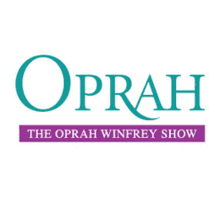Talk show
A talk show or chat show is a television programming or radio programming genre structured around the act of spontaneous conversation.[1][2][3] A talk show is distinguished from other television programs by certain common attributes.[4] In a talk show, one person (or group of people or guests) discusses various topics put forth by a talk show host.[5] This discussion can be in the form of an interview or a simple conversation about important social, political or religious issues and events.[6] The personality of the host shapes the tone of the show, which also defines the "trademark" of the show.[1][7] A common feature or unwritten rule of talk shows is to be based on "fresh talk", which is talk that is spontaneous or has the appearance of spontaneity.[1][3][7]

The history of the talk show spans back from the 1950s to current.[8]
Talk shows can also have several different subgenres, which all have unique material and can air at different times of the day via different avenues.[9]
Attributes
Amongst the inclusion of a host, a guest(s), and a studio or call-in audience, talk shows make up a distinguished category of television programming based on specific attributes.

- Talk shows are aired via some form of media and are focused on the viewers, which include the participants calling in, sitting in a studio or viewing from online or on TV.
- Talk shows center around the interaction of guests with opposing opinions and/or differing levels expertise, which include both experts and non-experts.
- Talk shows involve a host responsible for furthering the agenda of the show by remediating, instigating and directing the conversation to ensure the purpose is fulfilled. The purpose of talk shows is to either address or bring awareness to conflicts, to provide information, or to entertain.
- Talk shows consist of evolving episodes that focus on differing perspectives in respect to important issues in society, politics, religion or other popular areas.
- Although talk shows include guests of various expertise levels, they cater to the credibility of one's experiences and rationalities as opposed to educational expertise.
- Talk shows function to provide interviews, to address arguments, to play games, to reveal one's truths and to recant epiphanies gained through experiences.
- Talk shows are produced at low costs and are not aired during primal showtimes.
- Talks shows are either aired live or are recorded live with limited revisions. [4]
Subgenres

There are several major formats of talk shows. Generally, each subgenre predominates during a specific programming block during the broadcast day.
- Breakfast chat or early morning shows that generally alternate between news summaries, political coverage, feature stories, celebrity interviews, and musical performances.
- Late morning chat shows that feature two or more hosts or a celebrity panel and focus on entertainment and lifestyle features.
- Daytime tabloid talk shows that generally feature a host, a guest or a panel of guests, and a live audience that interacts extensively with the host and guests. These shows may feature celebrities, political commentators, or "ordinary" people who present unusual or controversial topics.
- "Lifestyle" or self-help programs that generally feature a host or hosts of medical practitioners, therapists, or counselors and guests who seek intervention, describe medical or psychological problems, or offer advice. An example of this type of subgenre is The Oprah Winfrey Show, although it can easily fit into other categories as well.[6]
- Evening panel discussion shows that focus on news, politics, or popular culture (such as the former UK series After Dark which was broadcast "late-night").
- Late-night talk shows that focus primarily on topical comedy and variety entertainment. Most traditionally open with a monologue by the host, with jokes relating to current events. Other segments typically include interviews with celebrity guests, recurring comedy sketches, as well as performances by musicians or other stand-up comics.
- Sunday morning talk shows are a staple of network programming in North America, and generally focus on political news and interviews with elected political figures and candidates for office, commentators, and journalists.
- Aftershows that feature in-depth discussion about a program on the same network that aired just before (for example, Talking Dead).
- Spoof talk shows, such as Space Ghost Coast to Coast, Tim and Eric Nite Live, Comedy Bang! Bang!, and The Eric Andre Show, that feature interviews that are mostly scripted, shown in a humorous and satirical way, or engages in subverting the norms of the format (particularly that of late-night talk shows).
These formats are not absolute; some afternoon programs have similar structures to late-night talk shows. These formats may vary across different countries or markets. Late night talk shows are especially significant in the United States. Breakfast television is a staple of British television. The daytime talk format has become popular in Latin America as well as the United States.
These genres also do not represent "generic" talk show genres. "Generic" genres are categorized based on the audiences' social views of talks shows derived through their cultural identities, fondness, preferences and character judgements of the talk shows in question.[6] The subgenres listed above are based on television programming and broadly defined based on the TV guide rather than on the more specific categorizations of talk show viewers. However, there is a lack of research on "generic" genres, making it difficult to list them here. According to Mittell, "generic" genres is of significant importance in further identifying talk show genres because with such differentiation in cultural preferences within the subgenres, a further distinction of genres would better represent and target the audience.[6]
Talk-radio host Howard Stern also hosted a talk show that was syndicated nationally in the USA, then moved to satellite radio's Sirius. The tabloid talk show genre, pioneered by Phil Donahue[10] in 1967[4] but popularized by Oprah Winfrey[11] was extremely popular during the last two decades of the 20th century.[12]
Politics are hardly the only subject of American talk shows, however. Other radio talk show subjects include Car Talk hosted by NPR and Coast to Coast AM hosted by Art Bell and George Noory which discusses topics of the paranormal, conspiracy theories, fringe science, and the just plain weird. Sports talk shows are also very popular ranging from high-budget shows like The Best Damn Sports Show Period to Max Kellerman's original public-access television cable TV show Max on Boxing.
History
Talk shows have been broadcast on television since the earliest days of the medium. Joe Franklin, an American radio and television personality, hosted the first television talk show. The show began in 1951 on WJZ-TV (later WABC-TV) and moved to WOR-TV (later WWOR-TV) from 1962 to 1993.[8]
NBC's The Tonight Show is the world's longest-running talk show; having debuted in 1954, it continues to this day. The show underwent some minor title changes until settling on its current title in 1962, and despite a brief foray into a more news-style program in 1957 and then reverting that same year, it has remained a talk show. Ireland's The Late Late Show is the second-longest running talk show in television history, and the longest running talk show in Europe, having debuted in 1962.
Steve Allen was the first host of The Tonight Show, which began as a local New York show, being picked up by the NBC network in 1954. It in turn had evolved from his late-night radio talk show in Los Angeles. Allen pioneered the format of late night network TV talk shows, originating such talk show staples as an opening monologue, celebrity interviews, audience participation, and comedy bits in which cameras were taken outside the studio, as well as music, although the series' popularity was cemented by second host Jack Paar, who took over after Allen had left and the show had ceased to exist.
TV news pioneer Edward R. Murrow hosted a talk show entitled Small World in the late 1950s and since then, political TV talk shows have predominantly aired on Sunday mornings.
Syndicated daily talk shows began to gain more popularity during the mid-1970s and reached their height of popularity with the rise of the tabloid talk show. Morning talk shows gradually replaced earlier forms of programming — there were a plethora of morning game shows during the 1960s and early to mid-1970s, and some stations formerly showed a morning movie in the time slot that many talk shows now occupy.
Current late night talk shows such as The Tonight Show Starring Jimmy Fallon, Conan and The Late Show with Stephen Colbert have aired featuring celebrity guests and comedy sketches. Syndicated daily talk shows range from tabloid talk shows, such as Jerry Springer and Maury to celebrity interview shows like Live with Kelly and Ryan, The Better Show, The Wendy Williams Show, Steve Wilkos, The Ellen DeGeneres Show and The Kelly Clarkson Show to industry leader The Oprah Winfrey Show which popularized the former genre and has been evolving towards the latter. On November 10, 2010, Oprah Winfrey invited several of the most prominent American talk show hosts - Phil Donahue, Sally Jessy Raphael, Geraldo Rivera, Ricki Lake, and Montel Williams - to join her as guests on her show. The 1990s in particular saw a spike in the number of "tabloid" talk shows, most of which were short-lived and are now replaced by a more universally appealing "interview" or "lifestyle TV" format.[13]
Talk shows have more recently started to appear on Internet radio. Also, several Internet blogs are in talk show format including the Baugh Experience.
The current world record for the longest talk show is held by Rabi Lamichhane from Nepal by staying on air for 62 hours from April 11 to 13, 2013 breaking the previous record set by two Ukrainians by airing the show for 52 hours in 2011.[14]
Talk shows around the world
Rabi Lamichhane from Nepal holds the present world record for longest ever talk show.
In Japan, panel shows — called "tooku bangumi" (トーク番組)in Japanese — are very commonplace, accounting for about 30% of daytime and prime-time programming on the four main television stations. Due to language and cultural differences, Japanese TV stations could not freely use syndicated programs (mostly from Europe and North America) and therefore turned to panel shows, which could be produced cheaply and easily, to fill time during daytime programming.
Japanese panel shows are distinct in generally not employing regular panelists but instead having a panel made up of different freelance comedians and celebrities each program, although the program is generally hosted by the same compere. Talk shows evolved in tandem with the Japanese variety show and it is very common for talk shows to borrow variety elements, typically by having celebrity guests attempt some kind of amusingly incongruous activity. Often, one of the guests will be a gaijin tarento (foreign talent) in order to provide comedy or to comment on matters related to Western culture. Comedic material is commonly written and rehearsed before tapings with or without a live audience.
Korean and Taiwanese talk shows have used the panel format similar to Japanese programs and rely on famous celebrities and comedic banter than topics. Their programs often shorten interviews from lengthy tapings.
In Brazil, Jô Soares inaugurated the genre with Jô Soares Onze e Meia ("Jô Soares Eleven Thirty") from 1988 to 1999. In 2000, Soares took his show's format to Rede Globo, where it was then called Programa do Jô, and hosts the program until the present day. Jô's main competitors are Danilo Gentili and Fábio Porchat. Weesibe Bbiri on Delta TV Uganda, hosted by Moses Wamala
Effects of COVID-19
The fear of the spread of the coronavirus lead to large changes in the operation of many talk shows in year 2020. In an effort to minimize the spread of COVID-19, many talk shows discontinued the use of live audiences to ensure adherence to the rules of social distancing.[15][16]
In March of 2020, several daytime talk shows, including On Air with Ryan Seacrest, began filming without a studio audience. Late-night talk shows, such as The Late Show With Stephen Colbert, The Tonight Show Starring Jimmy Fallon, Late Night with Seth Meyers, The Daily Show With Trevor Noah followed suite with a no-audience broadcast. Amongst the list of late-night talk shows were also those who only aired once a week, including Last Week Tonight with John Oliver and Full Frontal. Syndicated talk shows such as The View and Live With Kelly and Ryan carried on conversations without viewer participation. Even self-help or lifestyle talk shows such as Dr. Phil were amongst the talk shows that made the decision to eliminate an audience. Following the trend were game show talk shows with usually highly interactive audiences such as, Wheel of Fortune and Jeopardy, which also went forward without studio audiences. Furthermore, gossip tabloid talk shows such as The Wendy Williams Show broadcast in the absence of an audience.[15]
The inclusion of a live, participating audience is one of the attributes that contribute to the defining characteristics of talk shows.[4] Operating without the interaction of viewers created difficult moments and awkward silences to hosts who usually used the responses from viewers’ laughs, boos, and applause to transition the conversations. This lack of participation had a negative effect on many talk shows.[15][16]
See also
References
- Bernard M. Timberg, Robert J. Erler (2010) Television Talk: A History of the TV Talk Show, pp.3-4
- Erler, Robert (2010) "A Guide to Television Talk," in Television Talk: A History of the TV Talk Show, by Bernard M. Timberg
- Erving_Goffman (1981) Forms of Talk pp.234-160
- Ilie, C. (2006), "Talk Shows", Encyclopedia of Language & Linguistics, Elsevier, pp. 489–494, doi:10.1016/b0-08-044854-2/00357-6, ISBN 978-0-08-044854-1, retrieved July 23, 2020
- Stelter, Brian (September 30, 2010). "Anderson Cooper to Host Daytime Talk Show". NYTimes.com. Retrieved July 3, 2011.
- Mittell, Jason (2003). "Audiences Talking Genre: Television Talk Shows and Cultural Hierarchies". Journal of Popular Film and Television. 31 (1): 36–46. doi:10.1080/01956050309602867. ISSN 0195-6051.
- Television talk shows : discourse, performance, spectacle. Tolson, Andrew. Mahwah, N.J.: Lawrence Erlbaum. 2001. ISBN 0-8058-3746-9. OCLC 44592593.CS1 maint: others (link)
- Hinckley, David (November 26, 1999). "Joe Franklin: Truth in Packaging". New York Daily News. Archived from the original on July 3, 2009. Retrieved January 1, 2008.
- Television talk shows : discourse, performance, spectacle. Tolson, Andrew. Mahwah, N.J.: Lawrence Erlbaum. 2001. ISBN 0-8058-3746-9. OCLC 44592593.CS1 maint: others (link)
- Carter, Bill (February 26, 2003). "MSNBC Cancels the Phil Donahue Talk Show — New York Times". Nytimes.com. Retrieved July 3, 2011.
- Tannen, Deborah (November 28, 2009). "Op-Ed Contributor — Donahue Talked, Oprah Listened". NYTimes.com. Retrieved July 3, 2011.
- Carter, Bill (January 5, 1994). "Stern Reportedly Rules Out Late-Night TV Talk Show — New York Times". Nytimes.com. Retrieved July 3, 2011.
- "Donahue, Sally Jessy, Geraldo, Montel, Ricki: Talk Show Hosts—Where Are They Now?". Oprah.com. November 10, 2010. Retrieved July 3, 2011.
- "Nepali hosts longest-ever talk show". BBC News. April 13, 2013.
- Koblin, John (March 11, 2020). "TV Talk Shows Throw Out the Audience". The New York Times. ISSN 0362-4331. Retrieved July 24, 2020.
- Emily, Yahr (March 13, 2020). "Stephen Colbert, Jimmy Fallon go off the rails as their late-night shows have no audiences". The Washington Post. Retrieved July 21, 2020.
Further reading
- Niven, David; Lichter, S. R.; Amundson, Daniel (July 2003). "The Political Content of Late Night Comedy". The Harvard International Journal of Press/Politics. 8 (3): 118–133. doi:10.1177/1081180X03008003007.
- Priming Effects of Late-Night Comedy
- Late-Night Comedy and the Salience of the Candidates' Caricatured Traits in the 2000 Election